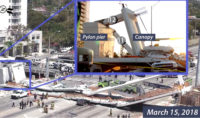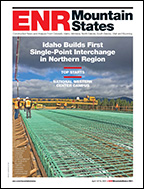Ending a 15-month investigation, the National Transportation Safety Board has determined that the probable cause of last year's fatal bridge collapse in Minneapolis was the failure of gusset plates due to a design error and the bridge's increased live and dead loads caused by earlier upgrades and the traffic and and construction materials and equipment on its deck at the time it fell.
Thirteen people were killed and 145 injured on Aug. 1, 2007, when most of the 41-year-old bridge fell into the Mississippi River.
In its probable-cause finding, which the board approved Nov. 14, NTSB also cited contributing factors, including the failure of the quality assurance procedures of the bridge designer, Sverdrup & Parcel and Associates Inc., to make sure calculations for the gusset plates on the bridge's main truss were done, and also federal and state transportation agencies' "inadequate design review."
Another contributing factor, the board said, was federal and state transportation officials' "generally accepted practice" of not giving adequate attention to gusset plates during inspections and also excluding the plates in load-rating analyses.
Sverdrup & Parcel was later acquired by Jacobs Engineering. Jacobs spokespersons couldn't immediately be reached for comment after the board's meeting.
In a summary of its still-to-be issued report, NTSB said the gusset plates that failed were at the U (for upper) 10 node of the steel truss. Those plates were about one-half inch thick, but national design standards called for them to be an inch thick. Plates at eight of the main trusses' 112 nodes were undersized, NTSB says.
Along with the probable cause, NTSB approved nine recommendations for safety improvement to the Federal Highway Administration and American Association of State Highway and Transportation Officials, including some that would require federal and state agencies to pay greater attention to gusset plates in activities such as bridge inspection.
NTSB also recommended that FHWA and AASHTO develop a bridge design quality assurance/quality control program.
In addition, NTSB recommends that AASHTO revise its bridge evaluation manual to add guidance for carrying out load ratings on new bridges before they open to traffic and to develop specifications for state DOTs to make sure that loads of construction materials on a bridge don't overload the structure.
NTSB's Acting Chairman, Mark Rosenker, told reporters after the end of the two-day meeting, "I think that the technical 'recs' that we made to [FHWA and AASHTO] will go a long to preventing this kind of accident from ever happening again." Rosenker adds, "There's now a recognition and a sensitivity to the significance of gusset plates and their appropriate design."
Tom Sorel, commissioner of the Minnesota DOT, who attended the NTSB session, told reporters, "As we've said all along, this is the report that we've all been waiting for. This is, in our minds, the definitive report. Now we'll take the results of the report and digest them and respond."
Sorel added, "We feel we have a strong responsibility to implement any recommendations that we've been provided with our bridge program and we'll take this very seriously. We won't wait for any national standards or national guidelines. We're going to move forward in Minnesota to implement the right standards, the right guidelines."
The U.S.DOT responded quickly to the board's recommendations. Transportation Secretary Mary E. Peters issued a statement announcing that she was directing FHWA to work with states to improve quality control during the design of bridges.
Peters also directed FHWA to revise its training manuals and inspection procedures to include specific guidance for reviewing gusset plates during all appropriate inspections.
Peters said, "The [NTSB's] final report should help close what has been a painful chapter for those who lost family and friends on that fateful day."
Some material on the NTSB investigation is available at www.ntsb.gov, but the full report won't be available for several weeks, a board spokesman said.





Post a comment to this article
Report Abusive Comment